Huan Xu
National University of Singapore
OuroMamba: A Data-Free Quantization Framework for Vision Mamba Models
Mar 13, 2025Abstract:We present OuroMamba, the first data-free post-training quantization (DFQ) method for vision Mamba-based models (VMMs). We identify two key challenges in enabling DFQ for VMMs, (1) VMM's recurrent state transitions restricts capturing of long-range interactions and leads to semantically weak synthetic data, (2) VMM activations exhibit dynamic outlier variations across time-steps, rendering existing static PTQ techniques ineffective. To address these challenges, OuroMamba presents a two-stage framework: (1) OuroMamba-Gen to generate semantically rich and meaningful synthetic data. It applies contrastive learning on patch level VMM features generated through neighborhood interactions in the latent state space, (2) OuroMamba-Quant to employ mixed-precision quantization with lightweight dynamic outlier detection during inference. In specific, we present a thresholding based outlier channel selection strategy for activations that gets updated every time-step. Extensive experiments across vision and generative tasks show that our data-free OuroMamba surpasses existing data-driven PTQ techniques, achieving state-of-the-art performance across diverse quantization settings. Additionally, we implement efficient GPU kernels to achieve practical latency speedup of up to 2.36x. Code will be released soon.
Deep Learning in Single-Cell and Spatial Transcriptomics Data Analysis: Advances and Challenges from a Data Science Perspective
Dec 04, 2024



Abstract:The development of single-cell and spatial transcriptomics has revolutionized our capacity to investigate cellular properties, functions, and interactions in both cellular and spatial contexts. However, the analysis of single-cell and spatial omics data remains challenging. First, single-cell sequencing data are high-dimensional and sparse, often contaminated by noise and uncertainty, obscuring the underlying biological signals. Second, these data often encompass multiple modalities, including gene expression, epigenetic modifications, and spatial locations. Integrating these diverse data modalities is crucial for enhancing prediction accuracy and biological interpretability. Third, while the scale of single-cell sequencing has expanded to millions of cells, high-quality annotated datasets are still limited. Fourth, the complex correlations of biological tissues make it difficult to accurately reconstruct cellular states and spatial contexts. Traditional feature engineering-based analysis methods struggle to deal with the various challenges presented by intricate biological networks. Deep learning has emerged as a powerful tool capable of handling high-dimensional complex data and automatically identifying meaningful patterns, offering significant promise in addressing these challenges. This review systematically analyzes these challenges and discusses related deep learning approaches. Moreover, we have curated 21 datasets from 9 benchmarks, encompassing 58 computational methods, and evaluated their performance on the respective modeling tasks. Finally, we highlight three areas for future development from a technical, dataset, and application perspective. This work will serve as a valuable resource for understanding how deep learning can be effectively utilized in single-cell and spatial transcriptomics analyses, while inspiring novel approaches to address emerging challenges.
Topological Symmetry Enhanced Graph Convolution for Skeleton-Based Action Recognition
Nov 20, 2024
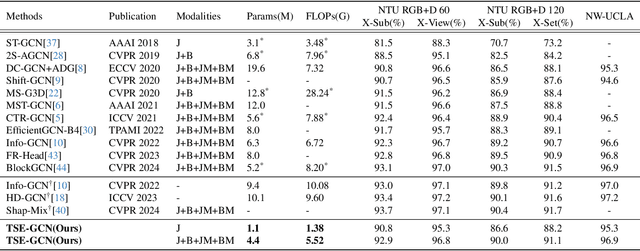

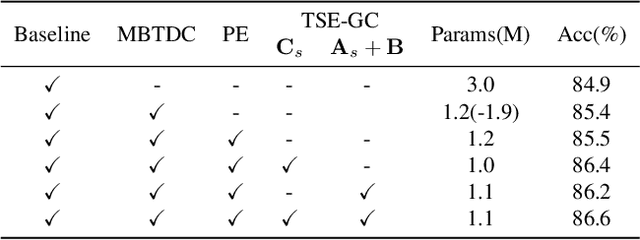
Abstract:Skeleton-based action recognition has achieved remarkable performance with the development of graph convolutional networks (GCNs). However, most of these methods tend to construct complex topology learning mechanisms while neglecting the inherent symmetry of the human body. Additionally, the use of temporal convolutions with certain fixed receptive fields limits their capacity to effectively capture dependencies in time sequences. To address the issues, we (1) propose a novel Topological Symmetry Enhanced Graph Convolution (TSE-GC) to enable distinct topology learning across different channel partitions while incorporating topological symmetry awareness and (2) construct a Multi-Branch Deformable Temporal Convolution (MBDTC) for skeleton-based action recognition. The proposed TSE-GC emphasizes the inherent symmetry of the human body while enabling efficient learning of dynamic topologies. Meanwhile, the design of MBDTC introduces the concept of deformable modeling, leading to more flexible receptive fields and stronger modeling capacity of temporal dependencies. Combining TSE-GC with MBDTC, our final model, TSE-GCN, achieves competitive performance with fewer parameters compared with state-of-the-art methods on three large datasets, NTU RGB+D, NTU RGB+D 120, and NW-UCLA. On the cross-subject and cross-set evaluations of NTU RGB+D 120, the accuracies of our model reach 90.0\% and 91.1\%, with 1.1M parameters and 1.38 GFLOPS for one stream.
Smart Audit System Empowered by LLM
Oct 10, 2024



Abstract:Manufacturing quality audits are pivotal for ensuring high product standards in mass production environments. Traditional auditing processes, however, are labor-intensive and reliant on human expertise, posing challenges in maintaining transparency, accountability, and continuous improvement across complex global supply chains. To address these challenges, we propose a smart audit system empowered by large language models (LLMs). Our approach introduces three innovations: a dynamic risk assessment model that streamlines audit procedures and optimizes resource allocation; a manufacturing compliance copilot that enhances data processing, retrieval, and evaluation for a self-evolving manufacturing knowledge base; and a Re-act framework commonality analysis agent that provides real-time, customized analysis to empower engineers with insights for supplier improvement. These enhancements elevate audit efficiency and effectiveness, with testing scenarios demonstrating an improvement of over 24%.
Bundle Adjustment in the Eager Mode
Sep 18, 2024



Abstract:Bundle adjustment (BA) is a critical technique in various robotic applications, such as simultaneous localization and mapping (SLAM), augmented reality (AR), and photogrammetry. BA optimizes parameters such as camera poses and 3D landmarks to align them with observations. With the growing importance of deep learning in perception systems, there is an increasing need to integrate BA with deep learning frameworks for enhanced reliability and performance. However, widely-used C++-based BA frameworks, such as GTSAM, g$^2$o, and Ceres, lack native integration with modern deep learning libraries like PyTorch. This limitation affects their flexibility, adaptability, ease of debugging, and overall implementation efficiency. To address this gap, we introduce an eager-mode BA framework seamlessly integrated with PyPose, providing PyTorch-compatible interfaces with high efficiency. Our approach includes GPU-accelerated, differentiable, and sparse operations designed for 2nd-order optimization, Lie group and Lie algebra operations, and linear solvers. Our eager-mode BA on GPU demonstrates substantial runtime efficiency, achieving an average speedup of 18.5$\times$, 22$\times$, and 23$\times$ compared to GTSAM, g$^2$o, and Ceres, respectively.
MROVSeg: Breaking the Resolution Curse of Vision-Language Models in Open-Vocabulary Semantic Segmentation
Aug 27, 2024
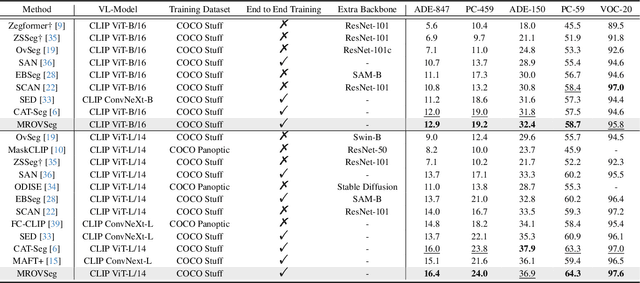

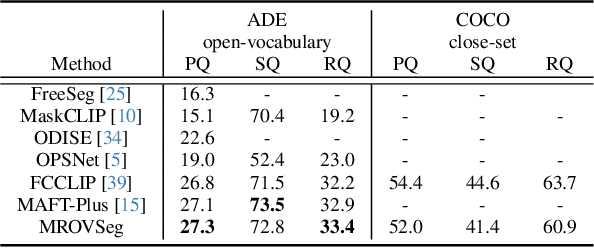
Abstract:Open-vocabulary semantic segmentation aims to segment and recognize semantically meaningful regions based on text-based descriptions during inference. A typical solution to address this task is to leverage powerful vision-language models (VLMs), such as CLIP, to bridge the gap between open- and close-vocabulary recognition. As VLMs are usually pretrained with low-resolution images (e.g. $224\times224$), most previous methods operate only on downscaled images. We question this design as low resolution features often fail to preserve fine details. Although employing additional image backbones for high-resolution inputs can mitigate this issue, it may also introduce significant computation overhead. Therefore, we propose MROVSeg, a multi-resolution training framework for open-vocabulary semantic segmentation with a single pretrained CLIP backbone, that uses sliding windows to slice the high-resolution input into uniform patches, each matching the input size of the well-trained image encoder. Its key components include a Multi-Res Adapter, which restores the spatial geometry and grasps local-global correspondences across patches by learnable convolutional and scale attention layers. To achieve accurate segmentation, we introduce Multi-grained Masked Attention scheme to aggregate multi-grained semantics by performing cross-attention between object queries and multi-resolution CLIP features within the region of interests. Through comprehensive experiments, we demonstrate the superiority of MROVSeg on well-established open-vocabulary semantic segmentation benchmarks, particularly for high-resolution inputs, establishing new standards for open-vocabulary semantic segmentation.
Transforming Surgical Interventions with Embodied Intelligence for Ultrasound Robotics
Jun 18, 2024



Abstract:Ultrasonography has revolutionized non-invasive diagnostic methodologies, significantly enhancing patient outcomes across various medical domains. Despite its advancements, integrating ultrasound technology with robotic systems for automated scans presents challenges, including limited command understanding and dynamic execution capabilities. To address these challenges, this paper introduces a novel Ultrasound Embodied Intelligence system that synergistically combines ultrasound robots with large language models (LLMs) and domain-specific knowledge augmentation, enhancing ultrasound robots' intelligence and operational efficiency. Our approach employs a dual strategy: firstly, integrating LLMs with ultrasound robots to interpret doctors' verbal instructions into precise motion planning through a comprehensive understanding of ultrasound domain knowledge, including APIs and operational manuals; secondly, incorporating a dynamic execution mechanism, allowing for real-time adjustments to scanning plans based on patient movements or procedural errors. We demonstrate the effectiveness of our system through extensive experiments, including ablation studies and comparisons across various models, showcasing significant improvements in executing medical procedures from verbal commands. Our findings suggest that the proposed system improves the efficiency and quality of ultrasound scans and paves the way for further advancements in autonomous medical scanning technologies, with the potential to transform non-invasive diagnostics and streamline medical workflows.
Enhancing Surgical Robots with Embodied Intelligence for Autonomous Ultrasound Scanning
May 01, 2024

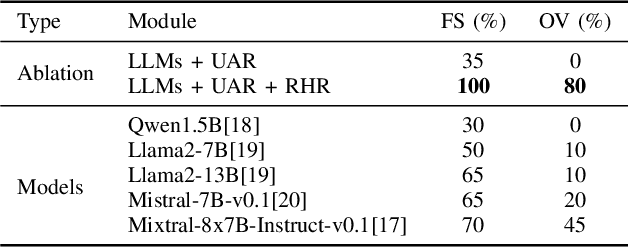
Abstract:Ultrasound robots are increasingly used in medical diagnostics and early disease screening. However, current ultrasound robots lack the intelligence to understand human intentions and instructions, hindering autonomous ultrasound scanning. To solve this problem, we propose a novel Ultrasound Embodied Intelligence system that equips ultrasound robots with the large language model (LLM) and domain knowledge, thereby improving the efficiency of ultrasound robots. Specifically, we first design an ultrasound operation knowledge database to add expertise in ultrasound scanning to the LLM, enabling the LLM to perform precise motion planning. Furthermore, we devise a dynamic ultrasound scanning strategy based on a \textit{think-observe-execute} prompt engineering, allowing LLMs to dynamically adjust motion planning strategies during the scanning procedures. Extensive experiments demonstrate that our system significantly improves ultrasound scan efficiency and quality from verbal commands. This advancement in autonomous medical scanning technology contributes to non-invasive diagnostics and streamlined medical workflows.
PWISeg: Point-based Weakly-supervised Instance Segmentation for Surgical Instruments
Nov 16, 2023



Abstract:In surgical procedures, correct instrument counting is essential. Instance segmentation is a location method that locates not only an object's bounding box but also each pixel's specific details. However, obtaining mask-level annotations is labor-intensive in instance segmentation. To address this issue, we propose a novel yet effective weakly-supervised surgical instrument instance segmentation approach, named Point-based Weakly-supervised Instance Segmentation (PWISeg). PWISeg adopts an FCN-based architecture with point-to-box and point-to-mask branches to model the relationships between feature points and bounding boxes, as well as feature points and segmentation masks on FPN, accomplishing instrument detection and segmentation jointly in a single model. Since mask level annotations are hard to available in the real world, for point-to-mask training, we introduce an unsupervised projection loss, utilizing the projected relation between predicted masks and bboxes as supervision signal. On the other hand, we annotate a few pixels as the key pixel for each instrument. Based on this, we further propose a key pixel association loss and a key pixel distribution loss, driving the point-to-mask branch to generate more accurate segmentation predictions. To comprehensively evaluate this task, we unveil a novel surgical instrument dataset with manual annotations, setting up a benchmark for further research. Our comprehensive research trial validated the superior performance of our PWISeg. The results show that the accuracy of surgical instrument segmentation is improved, surpassing most methods of instance segmentation via weakly supervised bounding boxes. This improvement is consistently observed in our proposed dataset and when applied to the public HOSPI-Tools dataset.
PyPose v0.6: The Imperative Programming Interface for Robotics
Sep 22, 2023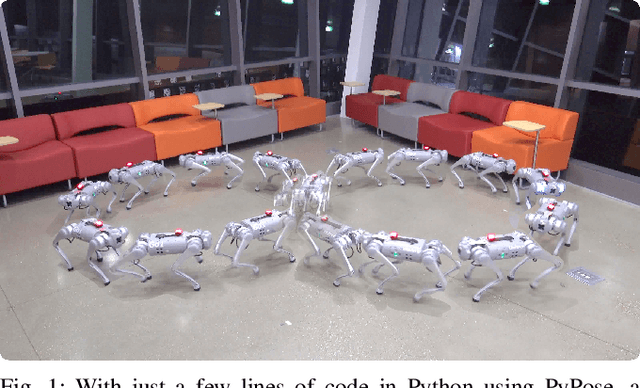
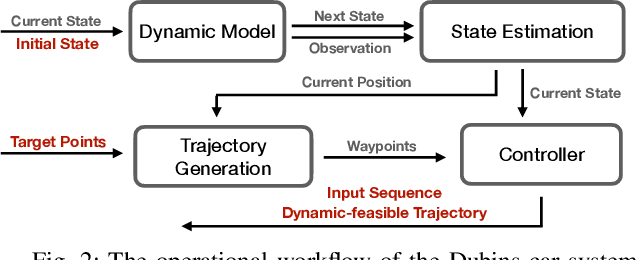
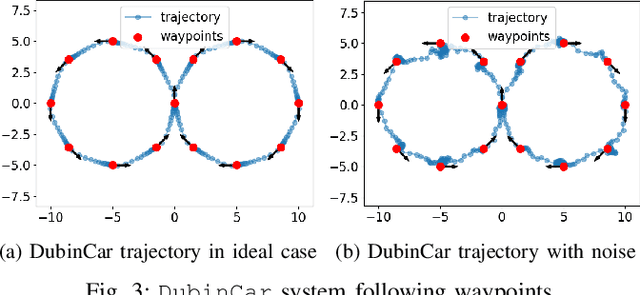
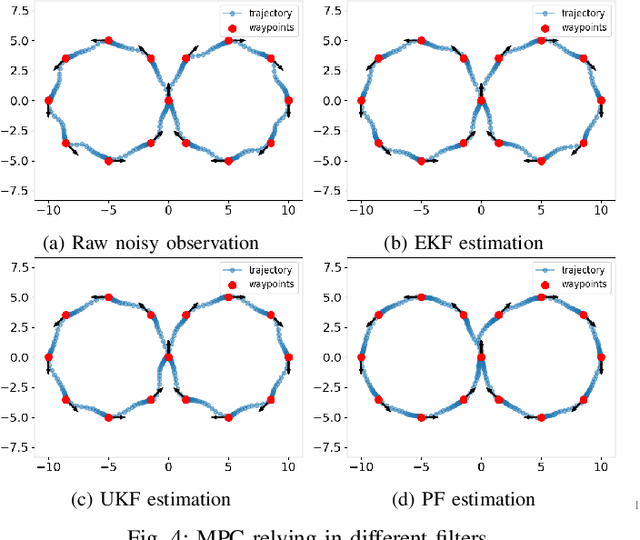
Abstract:PyPose is an open-source library for robot learning. It combines a learning-based approach with physics-based optimization, which enables seamless end-to-end robot learning. It has been used in many tasks due to its meticulously designed application programming interface (API) and efficient implementation. From its initial launch in early 2022, PyPose has experienced significant enhancements, incorporating a wide variety of new features into its platform. To satisfy the growing demand for understanding and utilizing the library and reduce the learning curve of new users, we present the fundamental design principle of the imperative programming interface, and showcase the flexible usage of diverse functionalities and modules using an extremely simple Dubins car example. We also demonstrate that the PyPose can be easily used to navigate a real quadruped robot with a few lines of code.
 Add to Chrome
Add to Chrome Add to Firefox
Add to Firefox Add to Edge
Add to Edge